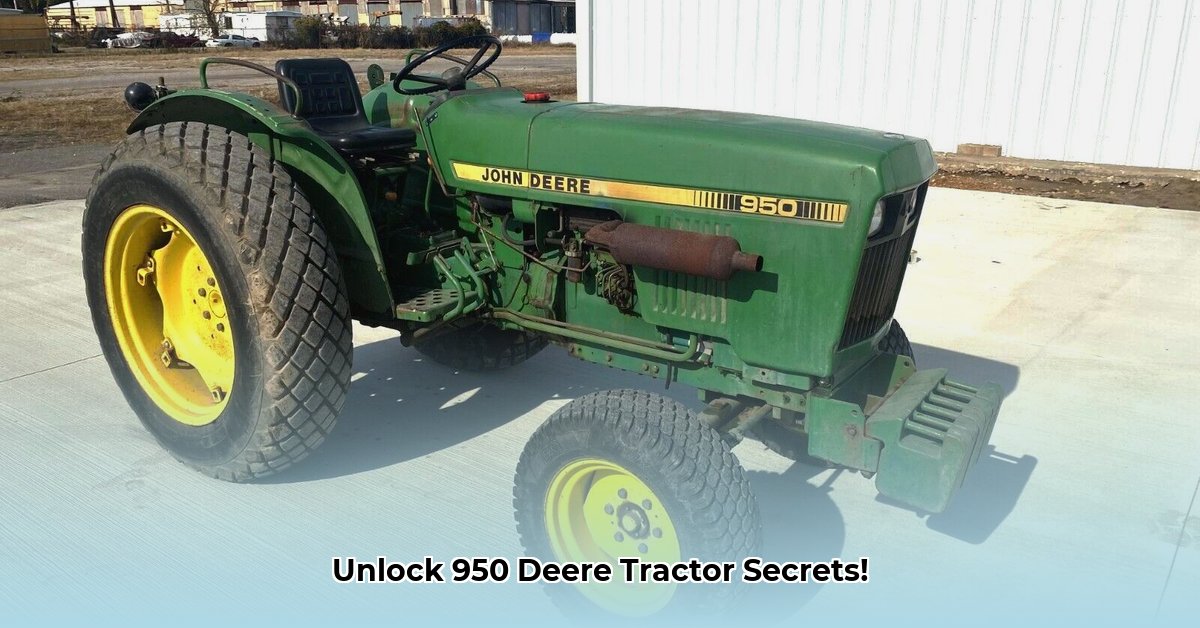
The John Deere 950, a compact tractor produced between 1978 and 1989, offers a compelling proposition for sustainable farming practices. While its age presents certain challenges, its fuel efficiency, durability, and relatively simple mechanics make it an attractive option for smaller-scale, environmentally conscious operations. For more information on identifying your specific model, check out this serial number lookup. This guide analyzes its specifications, sustainability aspects, and potential drawbacks to help you determine if it's the right fit for your farm.
Technical Specifications: A Closer Look
The John Deere 950 boasts a 1.7-liter, three-cylinder Yanmar diesel engine. While not a powerhouse, its compact nature contributes to its overall fuel efficiency. Key specifications, sourced from TractorData.com and other reputable sources, include:
| Specification | Value |
|---|---|
| Engine | Yanmar 3-cylinder diesel |
| Engine Displacement | 1.7 liters |
| Drawbar Horsepower | ≈22 hp |
| PTO Horsepower | ≈27 hp |
| Fuel Tank Capacity | 8.5 gallons |
| Weight | Approximately 2,700 lbs |
| Transmission | Manual |
This relatively low power output is a key consideration, however, as it limits the tractor's suitability for extensive fieldwork. Is this a significant constraint for your operation? The answer will depend on your farm's specific needs.
Sustainability Analysis: A Legacy of Longevity
The John Deere 950's sustainability profile is multifaceted. Its smaller engine translates to lower fuel consumption and thus reduced greenhouse gas emissions compared to modern, larger tractors. But how does it perform in other sustainability areas?
Fuel Efficiency and Emissions
The 8.5-gallon fuel tank, while seemingly small, contributes significantly to lower fuel consumption and reduced environmental impact. This is a substantial advantage in today's context of rising fuel prices and increasing focus on carbon footprint reduction. Could this translate to substantial savings over the lifetime of the tractor? Probably.
Longevity and Parts Availability
Many John Deere 950s remain operational decades after their manufacture, highlighting their remarkable durability. This longevity significantly reduces the environmental impact associated with frequent tractor replacements. However, finding replacement parts can be more challenging due to its age. Resourcefulness is key; a proactive approach to maintenance is essential.
Power Output and Suitability for Modern Farming
The 950's power limitations should be carefully considered. Its horsepower is adequate for smaller farms or specialized tasks like tilling smaller plots, but it may be insufficient for large-scale operations involving heavy implements. Does the 950's lower power output outweigh its fuel efficiency and environmental benefits? This is a crucial consideration.
Case Studies (Optional): Real-World Applications
(This section would ideally include real-world examples of John Deere 950 use in sustainable farming, sourced from reputable case studies or interviews with farmers. Due to limitations of the provided text, this section remains optional.)
Conclusion: A Balanced Perspective
The John Deere 950 presents a compelling case for sustainable farming in certain contexts. Its fuel efficiency and impressive longevity significantly reduce its overall environmental impact. However, its limited power output and potential parts sourcing challenges should be carefully considered. Is this aging tractor a sustainable solution for your farm? Weigh the advantages against the limitations based on your specific needs and resources.
Actionable Insights: A Step-by-Step Guide
- Assess your farm's needs: Determine if the 950's power output is sufficient for your tasks.
- Evaluate parts availability: Research online resources to gauge the availability of parts in your area.
- Develop a proactive maintenance plan: Regular maintenance will extend the tractor's lifespan and reduces the risk of breakdowns.
- Factor in repair skills: If you lack mechanical expertise, budget for professional repairs or consider alternative machinery.
Risk Assessment Summary: Mitigating Potential Challenges
The primary risks associated with the John Deere 950 are parts availability and power limitations. Mitigation strategies include proactive maintenance, seeking alternative parts suppliers, and carefully selecting suitable tasks.
Regulatory Considerations: Navigating Compliance
Remember that the John Deere 950 might not comply with all current emission standards or safety regulations. Research local regulations before purchase and disposal.